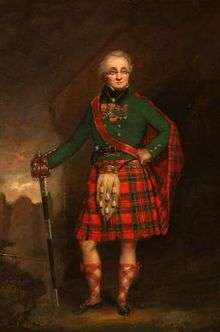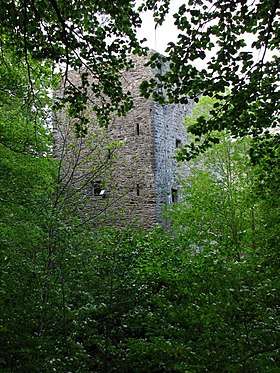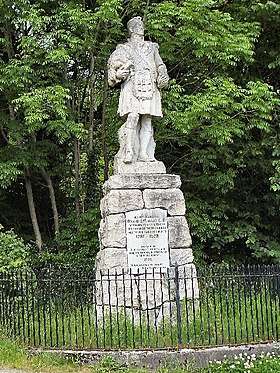David Stewart (major-general)
Major General David Stewart CB FRSE FLS FSA (Scot) (1 June 1772 in Garth House, Perthshire – 1829 in St. Lucia) was a Scottish soldier and later author and antiquarian, whose book, Sketches of the Character, Manners, and Present State of the Highlanders of Scotland[1][2] published in two volumes by Archibald Constable and Co in Edinburgh in 1822, was responsible for largely creating the modern image of the Highlander, the clans and Scottish regiments and is considered the foundation for all subsequent work on highlanders, clans and Scottish regiments system.[3][4]
Major-General David Stewart | |
|---|---|
 David Stewart of the Black Watch | |
| Nickname(s) | Davie |
| Born | 1 June 1772 Garth Castle, Perthshire |
| Died | unknown. St. Lucia |
| Allegiance | Scotland |
| Service/ | British Army |
| Years of service | 1783 to 1815 |
| Rank | Major General |
| Unit | 42nd Regiment of Foot, Black Watch |
| Commands held | Battle of San Juan (1797) Capture of Minorca (1798) Battle of Alexandria French Revolutionary Wars |


He is often referred to as Athollman.
Personal life
David Stewart was born at Garth Castle on 1 June 1772, the second son of Robert Stewart of Garth, Perthshire, and was descended from James Stewart (grandson of Robert II) who built Garth Castle, north-west of Aberfeldy, as a home for the chieftain of Clan Stewart of Atholl at the end of the fourteenth century. His mother was Janet Stewart, a cousin of his father.
He was an officer in the Black Watch regiment.
He was married to Christian Stewart, a cousin. They had a son, Neil Stewart and daughter, Jean Stewart. In 1819 he was elected a Fellow of the Royal Society of Edinburgh. His proposers were Lord Gray, Sir George Steuart Mackenzie and Sir David Brewster.[5]
In July 1822, after publishing his book, he succeeded to the estate of Garth by the death of his elder brother.
When George IV visited Edinburgh in August 1822, Stewart helped Sir Walter Scott in the reception arrangements, headed the Celtic club in the procession, adjusted the royal plaid for the levée, and pronounced the king ‘a vera pretty man’ (Lockhart). He was promoted to major-general on 27 May 1825, and in 1829 he went moved to Saint Lucia as governor.
On 18 December 1829 he succumbed to the numerous wounds received during his military life, and died of fever on St Lucia.[6]
Military life
He was given a commission as ensign in the 77th, (Atholl Highlanders) on 21 April 1783, but that regiment was disbanded soon afterwards. He joined the 42nd highlanders (later Black Watch) on 10 Aug. 1787, and became lieutenant on 8 Aug. 1792, and captain-lieutenant on 24 June 1796. He served with the 42nd in Flanders in 1794 during the French Revolutionary Wars under the Duke of York, and went with it to the West Indies in October 1795. As part of the Napoleonic wars, he took part in the capture of the French colonies of St. Lucia and St. Vincent. He was also in the unsuccessful expedition against Porto Rico (Battle of San Juan) in 1797.[3]
Stewart returned to Europe with his regiment, and garrison at Gibraltar. Stewart embarked there with the expedition which resulted in the capture of Minorca in November 1798 (Capture of Minorca (1798)). But he was taken prisoner at sea, and was detained for a total of five months in Spain before he was exchanged. He went to Egypt with Abercromby's expedition ((Egyption expedition)), and was severely wounded at the battle of Alexandria on 21 March 1801. Three months before this, on 15 Dec. 1800, he had obtained a company in the 90th (Perthshire volunteers), but he returned to the 42nd on 23 July 1802.[3]
He obtained a majority in the 78th highlanders, on 17 April 1804, by raising recruits for the second battalion which was then being formed, a thing which his popularity in the highlands made easy to him. His men were so much attached to him that when he was at Shorncliffe army barracks, in the following year, Sir John Moore interposed to prevent his being sent to India to join the 1st battalion. He went with the 2nd battalion to the Mediterranean in September 1805, and shared in the descent on Calabria. At Maida, on 4 July 1806, under General John Stuart, he commanded a battalion of light companies and ensuring the defeat of the French under Jean Reynier outside the town. He was again severely wounded. He was appointed lieutenant-colonel of the West India rangers on 21 April 1808, and took part in the capture of Guadaloupe in 1810. He received a medal with one clasp for this and the operation at Maida, and in 1815 he was made C.B. He was promoted colonel in the army on 4 June 1814, and in the following year he was placed on half-pay.[3]
Book
In 1817, the officer commanding the 42nd, applied to Stewart for information regarding the history of the regiment, as its records had been lost. The inquiries which were undertaken by the request gradually developed into the Sketches of the Character... book, which was published in two volumes at Edinburgh in 1822. John Stuart Blackie stated of the book:
- whose excellence shines forth on every page,
has been the foundation of all subsequent works on the clans. The first two parts of it, dealing with the country and the people, occupy about half of the first volume; the remainder is devoted the annals of Scottish regiments.
- Remarks on Colonel Stewart's Sketches of the Highlanders
were published at Edinburgh in 1823, admitting its merits, but objecting to its Jacobite sympathies. Stewart had thoughts of writing a history of the rebellion of 1745, but gave it up.[3]
References
- Stewart, David. "Sketches of the character, manners, and present state of the Highlanders of Scotland – With details of the military service of the Highland regiments – Vol. I" (1825) [Textual Record]. collections of New York Public Library., ID: CIHM 54082, pp. 661. archive.org: American Libraries. OCLC 1296777.
- Stewart, David. "Sketches of the character, manners, and present state of the Highlanders of Scotland – With details of the military service of the Highland regiments – Vol. II" (1822) [Microfilm]. University of Alberta Libraries – The CIHM Monograph Collection., ID: CIHM 54082, pp. 585. archive.org: Canadiana.org. OCLC 15990352.
- "Stewart, David (1772-1829) (DNB00)". wikisource.org. Retrieved 3 April 2014.
- Stephen, Sir Leslie (1832–1904). Dictionary of national biography volume 54 of 63. New York Macmillan.
- Biographical Index of Former Fellows of the Royal Society of Edinburgh 1783–2002 (PDF). The Royal Society of Edinburgh. July 2006. ISBN 0-902-198-84-X.
- https://www.electricscotland.com/history/other/stewart_david.htm